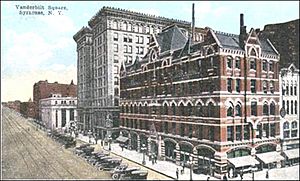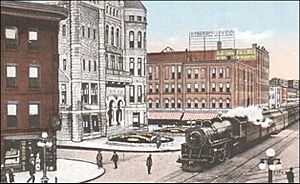Railroads in Syracuse, New York facts for kids
The railroad industry in Syracuse, New York began in October 1831. A big meeting in the city helped kick off the age of railroads. This led to steam trains coming to New York State.
At that time, the oldest railroad in Onondaga County was already two years old. This meeting helped create the train lines that later joined together in 1853. They formed the famous New York Central Railroad.
Contents
- How Railroads Started in Syracuse
- The Auburn & Syracuse Railroad
- Vanderbilt Square: A Busy Hub
- The Syracuse & Utica Railroad
- Syracuse & Utica Direct Railroad
- Syracuse Stone Railroad
- Railroad Competition and New Lines
- Syracuse & Binghamton Railroad
- Direct Railway to Rochester
- Rochester & Syracuse Railroad
- Salina Street and City Views
- The New York Central Railroad
- More Railroad Lines
- West Shore Railroad
How Railroads Started in Syracuse
In October 1831, Syracuse hosted its first railroad meeting. New York State's oldest railroad, the Mohawk & Hudson, was less than three years old. Soon after, the Auburn & Syracuse Railroad was created. Auburn was a bigger village than Syracuse back then. That is why its name came first in the company's title.
The Auburn & Syracuse Railroad
People in Syracuse invested $31,000 in the Auburn & Syracuse Railroad. The company was allowed to raise $400,000 in total. Vivus W. Smith was one of the 20 investors. He later helped start the Syracuse Journal newspaper.
The Auburn & Syracuse Railroad opened on January 8, 1838. At first, horses pulled the trains. On June 4, 1839, the first steam locomotive, named "Syracuse," began running. It pulled trains on wooden tracks. By 1839, a train could travel 26 miles (42 km) in 58 minutes. The company built a new station in late 1838. It was located between Salina and Clinton streets.
This station was replaced in 1839 by the Syracuse and Utica Railroad's new depot. The Auburn road's station was not very fancy. It looked very different from its grand neighbor across the street.
Steam trains finally arrived in Syracuse. A large pond blocked the train tracks at first. This pond was where the State Armory is today. A wooden bridge, called a trestle, had to be built over the pond. Before the trestle, passengers had to get off in Geddes. They had to find other ways to reach Syracuse. The trestle and a new station were finished in early 1839.
Vanderbilt Square: A Busy Hub
Vanderbilt Square was home to Syracuse's first railroad station. It opened in early 1839. Trains were very important for travel back then. The square was often covered in soot from the locomotives. Train tracks ran right down the middle of the street. The new station had doors at both ends. These doors closed after trains arrived and left.
For many years, life in Syracuse centered around Vanderbilt Square. The train station and nearby hotels were the main attractions. Many famous people visited the old station. Henry Clay was welcomed there for the New York State Fair in 1849. Daniel Webster, General Winfield Scott, and Stephen A. Douglas also visited.
The Syracuse & Utica Railroad
A second railroad was built from Syracuse to Utica. This route was 53 miles (85 km) long. It passed through Oneida and Rome. On July 1, 1837, Syracuse allowed the railroad to use Washington Street. This railroad also used the station in Vanderbilt Square.
John Wilkinson was the first postmaster of Syracuse. He gave the village its name. He became president of the Syracuse & Utica Railroad. Vivus Smith was the first secretary. Thanks to them, the railroad's main office was in Syracuse, not Utica. This brought an important industry to the village.
Daniel Elliott designed and built the Syracuse and Utica Railroad station. It was known for its beautiful design. The station was sometimes used for town meetings or speeches. Important people like Martin Van Buren and Henry Clay were welcomed there. The building soon became too small. Offices moved to other nearby places. A new station was later built on Franklin Street.
President Wilkinson ordered the first "flat car" for the line. Passengers wanted a car to carry their purchases from Syracuse back to Utica. This was the first "freight car" in the country. It was the start of modern freight shipping.
The railroad had its first public run on July 4, 1839. The company laid its tracks along Washington Street. The New York Central Railroad later kept the right to use these tracks.
Syracuse & Utica Direct Railroad
In 1852, a new company called the Syracuse & Utica Direct Railroad appeared. It planned to build a more direct line from Syracuse to Utica. This new route would go through Vernon. It would cut travel time from four hours to three and a half hours.
Because of this new competition, the Syracuse & Utica Railroad decided to add a second track. They "double-tracked" their line through Washington Street.
Syracuse Stone Railroad
The Syracuse Stone Railroad Company connected the city to the Onondaga stone quarries. This small railroad linked the Auburn & Syracuse Railroad from Geddes to the city. It also connected to the station at Vanderbilt Square.
Railroad Competition and New Lines
The Oswego & Syracuse Railroad started in 1848.
Syracuse & Binghamton Railroad
The Syracuse & Binghamton Railroad opened in 1854. This was a year after the New York Central Railroad was formed. It connected to the earlier Syracuse & Oswego Railroad line. Both lines later came under the control of the Delaware, Lackawanna and Western Railroad in 1870. This was tricky because one railroad used wide tracks and the other used standard tracks.
Direct Railway to Rochester
The Direct Railway Company was created in 1848. It was planned as a direct route between Syracuse and Rochester. This would shorten the trip by 23 miles (37 km). The Auburn & Rochester Railroad was less direct. It stopped at many villages along the way.
Rochester & Syracuse Railroad
The Rochester & Syracuse Railroad Company was formed in 1853. They were allowed to build a direct route. They also took over the rights of the Direct Railway Company. This railroad opened in June 1853. This was two months before the New York Central Railroad was officially formed.
Salina Street and City Views
The first street railway was built on Salina Street in 1859. This allowed tourists to see more of Syracuse. Travelers got "close-up views" of the city, its people, stores, and houses. The trains slowed down as they went through town.
On February 18, 1861, Abraham Lincoln waved from a train platform. He was on his way to become president. On April 26, 1865, his funeral train stopped for 30 minutes.
The Oakwood and Geddes horse car lines were built in 1863.
The New York Central Railroad
Seven railroads in Central New York eventually merged. This was hinted at as early as 1842. By then, it was possible to travel between Buffalo and Albany. You only needed to change trains in Rochester.
On January 31, 1843, the seven railroad companies met in Albany. They agreed to run two "through" trains daily. These trains would go between the Hudson River and Lake Erie. The trip took 25 hours and cost $11.50 for first class. The average speed was 13 mph (21 km/h) over the 326-mile (525 km) trip.
Some of these railroads began to combine by April 2, 1853. The New York State Legislature passed a law. It allowed any of the ten railroads between the Hudson River and the Great Lakes to merge. By July 7, 1853, the railroad directors had agreed. This was the start of the New York Central Railroad. It grew westward from Buffalo. It also expanded to New York City by using the Hudson River Line.
The old New York Central Railroad station was torn down in February 1870. A new station was built on Franklin and West Fayette streets. This was at the edge of Armory Square. It was used until 1895. A third station was then built. The third station was torn down in 1936.
More Railroad Lines
In the 1870s, two new railroads were built. These were the Syracuse, Chenango & New York Railroad and the Syracuse & Northern. The Syracuse, Chenango & New York went through the Chenango Valley. The Syracuse & Northern went to Watertown, New York. Both of these railroads later joined the New York Central Railroad.
West Shore Railroad
The West Shore Railroad opened a route to New York City in 1848. A "rate war" (where companies lower prices to compete) caused the railroad to fail. It was then leased to the New York Central Railroad.
The West Shore Railroad got permission to operate in Syracuse in 1881. It opened on October 1, 1883.
The Syracuse & Utica Railroad made its first arrival in 1889. The locomotive named Syracuse pulled the first train out of the old station on June 4, 1889. It traveled over the Auburn road.




